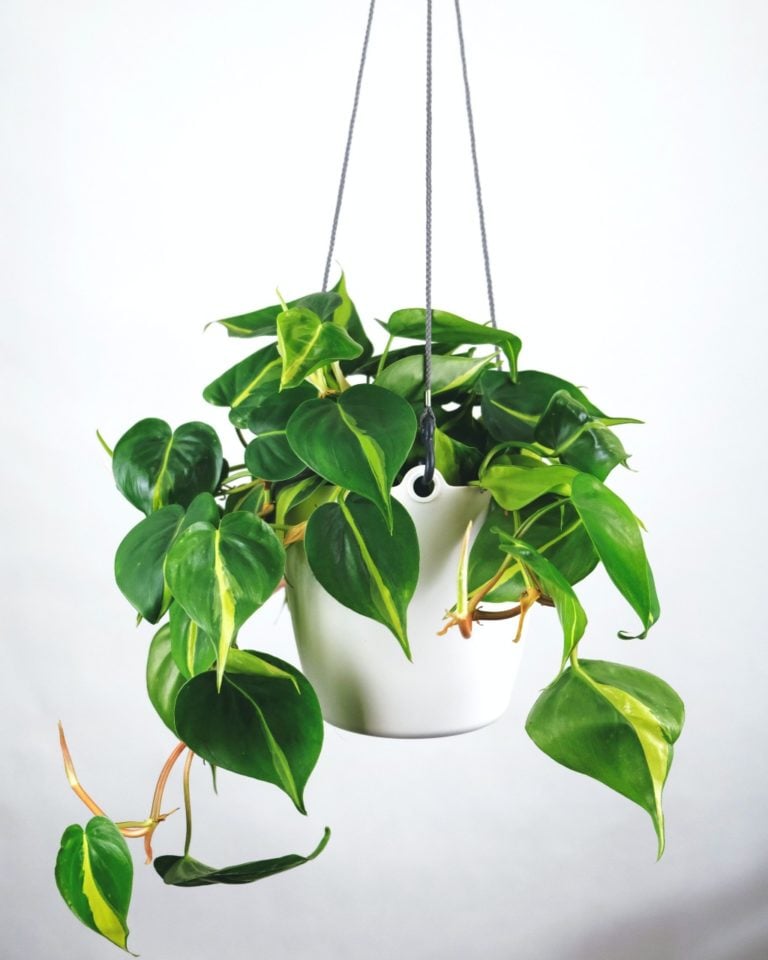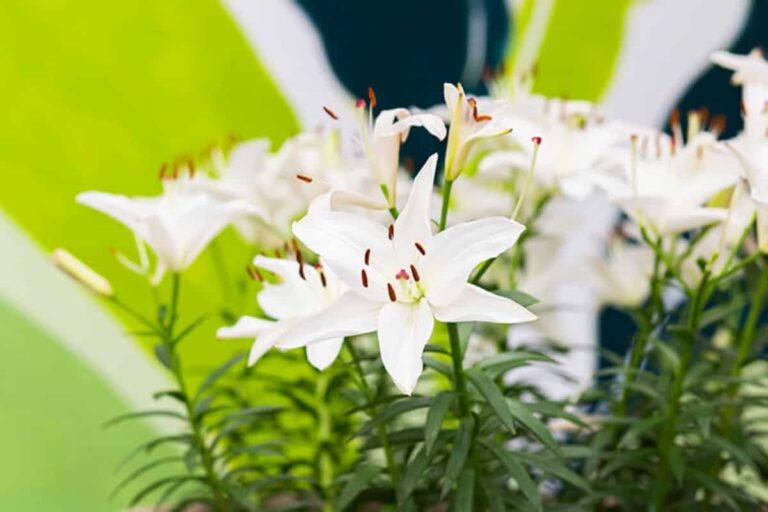10 Cherry Tree Diseases That You Need To Know About
If you find a cherry tree that isn’t blooming well, it is safe to say that it is undergoing a health crisis. Just like most trees, cherry trees are also highly susceptible to heaps of diseases. If undiagnosed or left untreated, these issues can affect the plant and even prove to be lethal in some cases. Luckily, cherry trees show apparent indications of their symptoms; you can thus cure these recognizable symptoms to keep your trees healthy and thriving. We recommend reading further to understand these diseases in detail along with their treatments and preventative measures.
#1 Black Knot
Black knot is the most common disease found in the cherry tree lineage. The pathogens traveling through the wind and rain carry the knot fungus. These pathogens usually travel and germinate in spring, while the knots start appearing once fall arrives. The disease affects the fruiting and blossoming of the cherry tree and even causes branches to fall and stunt the leaves’ growth.
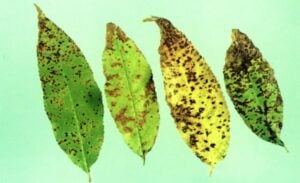
Symptoms
This disease causes severe swellings on the cherry tree twigs, branches, and even trunk. Later, a knot appears that projects an olive green or black color, thus giving it its name- a black knot.
How to treat
Pruning away the affected part is the best way to get rid of this disease. It would be best if you cut all the twigs and branches exhibiting any fungal infestation. Ensure you burn down all the residue to prevent future infections.
Prevention
Always prune early infection sites to prevent the spread. Consider opting for lime-sulfur spray or an organic fungicide for the treatment and lastly, keep your pruning accouterments highly sterilized.
#2 Brown Rot
Kansan cherry plants are more susceptible to brown rot disease than any other cherry tree species. This disease attacks blossoming trees and shifts from leaves to fruits very quickly.
Brown rot occurs from the toxic spores that travel through the wind, but many birds can also be carriers. Humid and warm climates usually speed up the rotting process.
Symptoms
Brown rot causes the browning of the cherries and leaves. Trees affected with brown rot can shed and lose their entire harvest within quite some time.
How to treat
Sadly no treatment works for cherries that are already affected. However, pruning and burning the leaves and twigs can work efficiently to stop the spread.
Prevention
Plant and keep the trees in an adequately aerated atmosphere to prevent brown rot. Try to remove all the unnecessary plant debris around the base of the cherry tree to avoid fungus.
#3 Cherry Leaf Spot
Cherry leaf spot disease can affect all species, but the English Morello trees are more inclined to suffer from this issue. Another common name for this disease is yellow leaf disease. Leaf spot usually occurs when fungi produce spores and germinate on healthy leaves by traveling through rain or wind.
Symptoms
As the name says, this disease shows signs of small brownish-purple spots on the leaves. These spots dry out the cherry leaves, forcing them to fall. Severe infestation can even wipe out the entire tree.
How to treat
Carefully remove the infected leaves to control the bacteria from further spreading. Always burn the leaves to eliminate the risk of spore transmission. A mixture of baking soda, dish soap, and water may effectively curb the leaf spots.
Prevention
Ensure your tree is adequately fed and watered. Spraying a good dose of fungicide can prevent the spores from activating.
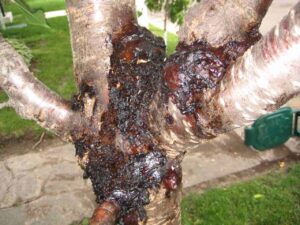
#4 Cytospora Canker
Cytospora Canker usually affects both sweet and sour cherry tree varieties. This disease arises in a warm and humid environment and can even occur because of sunburn or various pathogen-bearing insects.
Symptoms
You will start noticing cankers in deep dark colors that will eventually lead to wilting of branches. Cytospora Canker infects the wood of the tree by infiltrating through bark injuries. It usually presents as a tiny necrotic spot on such injured limbs and later spreads through the wood tissue.
How to treat
Unfortunately, there is no chemical treatment to treat cankers, but you can prune all the infected barks to stop the growth. Since the disease only affects damaged barks, ensure to cut down such damaged barks and twigs.
Prevention
The best prevention is to maintain the vitality of your trees through proper upkeep. You should train young cherry plants to avoid branch breaking.
#5 Powdery Mildew
Powdery Mildew happens to various cherry trees and is considered less dangerous than the other diseases. However, getting rid of powdery mildew can be quite challenging. This disease starts from spore transmission via wind or rain.
Symptoms
You will see a thick layer of power-like substance on the leaves of your cherry tree. Powdery mildew mainly attacks young plants that haven’t developed proper disease resistance.
How to treat
The only definite way to completely get rid of powdery mildew is to prune the affected leaves. Keeping your plants in a fixed colder environment can also discourage the disease from spreading any further.
Prevention
Avoid over watering the plant and abstain from planting the trees extremely close to each other. Excellent and proper air circulation will keep the cherry plants healthy and miles away from the disease.
#6 Necrotic Ringspot
Necrotic ringspot is an indeed dangerous disease that tends to affect most cherry tree species. This disease affects cherries harder than any other part of the plant. The most common reason for its spread is pollen, wood grafting, wind, and seeds transmission.
Symptoms
The main symptoms of necrotic ringspot showcase the browning or yellowing of leaves with stunted growth. This disease may also cause holes, further killing the buds and twigs of the entire plant.
How to treat
Currently, there’s no way to cure trees that are affected by necrotic ring spots. The possible treatment is to remove the entire tree to avoid the spread of the disease.
Prevention
It can be difficult to prevent since it is spread through seeds, pollen, and wood grafting. However, we highly recommend choosing disease-resistant cultivars as much as possible.
#7 Silver Leaf
Silver leaf is yet another common fungal disease that affects most Prunus family including cherry trees. This fungal infection attacks the wood and leaves of the cherry tree by entering through wounds or scratches of the branch.
Symptoms
One can identify a silver leaf by its silvery sheen appearance on the cherry leaves. The leaves on such trees end up turning brown and thus decaying pre-maturely. As the disease advances, you can spot small mushroom-shaped tumors on the branches.
How to treat
You can start by removing the dark leaves and conks from your cherry tree. Pruning away these parts can reduce the infestation of the disease to a greater extent. Refrain yourself from wounding the tree during humid conditions.
Prevention
Always prune at the correct time of the year, especially during late May to June. Make a habit of keeping your shears and pruning equipment sterilized and clean.
#8 Verticillium Wilt
Verticillium wilt is one of the worst fungal infections that can harm your cherry trees quite severely. Most trees tend to die once it gets riddled with Verticillium Wilt.
Symptoms
The main symptoms include withering of the leaves with additional stunted growth. You will also notice a smaller cherry size than regular ones.
How to treat
Unfortunately, the older a cherry tree gets, the harder it is to recover from this disease. Reviewing the soil’s history is essential for young plants. Lastly, keep the tree well fertilized and watered.
Prevention
Ensure that the soil is adequately rich in nutrients. Guttering out a proper drainage system will make your tree less susceptible to fungus.
#9 X-Disease
Cherry x-disease is a disease transmitted via insects that transfer pathogenic phytoplasma from wild plants to domestic ones. This pathogen can be highly fatal, especially for cherry trees.
Symptoms
Infected trees tend to bear small, pale cherries with extra leathery skin. The leaves also process a bronzed complexion.
How to treat
One can treat less severe cases by pruning away the branches and leaves. This step will stop the spread but won’t cure the already affected tree.
Prevention
The most practical way to prevent this fatal x-disease is to remove all plants that host the disease-carrying insects. Treating the trees with safe pesticides can bring positive results.
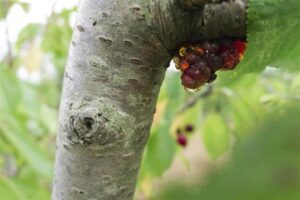
#10 Crown Gall
Crown gall is considered the cancer of cherry tree diseases. This disease is caused by harmful bacteria getting absorbed into a cherry tree’s DNA. The bacteria then start creating tumor cells that eventually spread throughout the entire tree.
How to treat
To treat this disease, one needs to spray various chemical substances on the infected branches and areas. Removing these tumors can indeed effectively heal your tree.
Prevention
One must note that crown gall usually thrives in wet ecosystems and warm temperatures. To prevent this disease, try to keep their crown dry and ensure you plant the cherry tree in well-draining soil. Furthermore, avoid plant breakage and wounding as much as possible.
Conclusion
We hope this list helped you become more aware of the various diseases associated with cherry trees. We highly recommend taking all the preventative measures to avoid dealing with such conditions in the first place. If, unfortunately, your tree gets diseases, consider using the advice mentioned above to stop the spread.
Ref –
https://gardenerdy.com/ornamental-cherry-tree-diseases
https://www.gardeningknowhow.com/edible/fruits/cherry/what-is-cherry-tree-gall.htm

